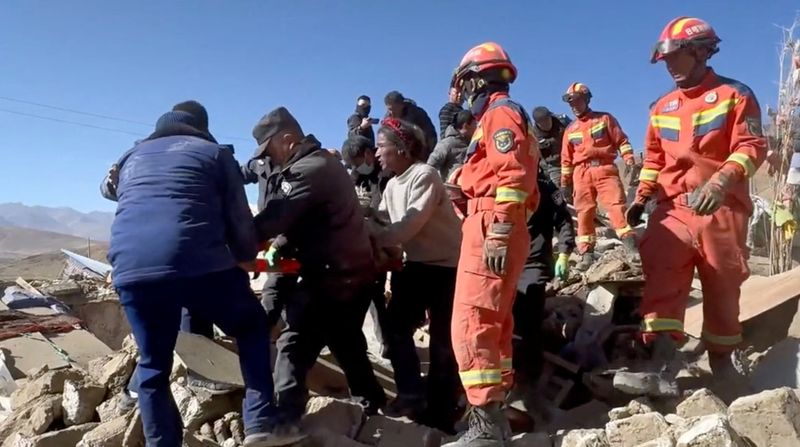
BEIJING (Reuters) – More than 400 people trapped by a powerful earthquake in the foothills of the Himalayas have been rescued, Chinese officials said, while more than 30,000 residents have been moved elsewhere, as the search for survivors entered its second day on Wednesday.
The epicenter of the 6.8-magnitude earthquake that occurred on Tuesday, one of the strongest tremors the region has witnessed in recent years, was located in Tengri in the Tibet region of China, about 80 kilometers north of Mount Everest, the highest mountain in the world. It also shook buildings in neighboring Nepal, Bhutan and India.
Twenty-four hours after the earthquake, survivors trapped under the rubble will have endured a night in subzero temperatures and will be at risk of succumbing to hypothermia and dehydration.
A preliminary study showed that 3,609 homes were destroyed in Tibet's Shigatze region, home to 800,000 people, Chinese state media reported late Tuesday, citing local officials. More than 500 people and 106 ambulances were sent to help the injured.
State broadcaster CCTV reported that at least 126 people were killed and 188 injured on the Tibetan side. No deaths have been reported in Nepal or elsewhere.
Temperatures in the highland region dropped to minus 18 degrees Celsius (0 degrees Fahrenheit) overnight, adding to the misery of those left homeless.
The television added that tents, food rations, generators and other supplies arrived at the site late on Tuesday, and all parts of the road damaged by the earthquake were reopened.
Southwestern parts of China, Nepal and northern India are frequently hit by earthquakes caused by the collision of the Indian and Eurasian tectonic plates, pushing up the ancient sea that is now the Qinghai-Tibet Plateau.
The entire plateau is seismically active, as well as its eastern and northern edges overlapping the Chinese provinces and regions of Sichuan, Gansu and Qinghai.
Beijing, which administers Tibet as an autonomous region within China, rejects criticism from human rights groups and exiles who accuse it of violating the religious and cultural rights of the Tibetan people.
The China Earthquake Networks Center said that more than 500 aftershocks with a magnitude of 4.4 followed the quake as of 8 a.m. (0000 GMT) on Wednesday.
Over the past five years, 29 earthquakes with a magnitude of 3 or more have occurred within 200 kilometers of the epicenter of Tuesday's quake, according to the Sichuan Provincial Seismological Bureau.

In 2008, an 8.0-magnitude earthquake struck the city of Chengdu in Sichuan, killing at least 70,000 people, the deadliest earthquake to hit China since the 1976 Tangshan earthquake, which killed at least 242,000 people.
Tuesday's earthquake was the worst since a 6.2-magnitude earthquake occurred in 2023, killing at least 149 people in a remote area in the northwest of the country.








